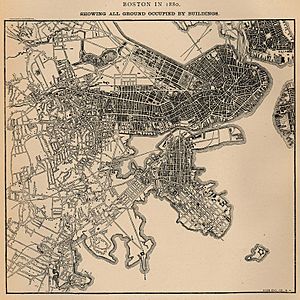Calf Pasture Pumping Station Complex facts for kids
Quick facts for kids |
|
|
Calf Pasture Pumping Station Complex
|
|
 |
|
| Location | Boston, Massachusetts |
|---|---|
| Area | 9.5 acres (3.8 ha) |
| Built | 1883 |
| Architect | Clough, George Albert |
| Architectural style | Queen Anne, Romanesque |
| NRHP reference No. | 90001095 |
| Added to NRHP | August 2, 1990 |
The Calf Pasture Pumping Station Complex is an important old building in Boston, Massachusetts. It was built in the 1880s to help keep the city clean. This building is located on Columbia Point in the Dorchester area.
What Was the Calf Pasture?
Before the pumping station was built, the land was very different. For a long time, from the 1600s to the mid-1800s, this area was known as a "calf pasture." It was a marshy, empty place where people from nearby Dorchester would bring their young cows, called calves, to graze.
The land was originally about 14 acres. Over time, especially in the 20th century, a lot of new land was created by filling in marsh areas. This made the total area much larger, growing to about 350 acres.
Building the Pumping Station
In the 1880s, Boston needed a better way to handle its sewage. The Calf Pasture area was chosen for a new sewage pumping station. This large building, made of granite, was finished in 1883. It was the very first sewage treatment station built in Boston.
The pumping station was a big step forward for public health. It helped make city living much cleaner and healthier. The station worked by pumping waste far away to a special treatment facility on Moon Island in Boston Harbor. This system was so good that other cities around the world used it as a model.
The Calf Pasture Pumping Station was the main part of Boston's sewer system for many years. It handled all of the city's sewage until 1968. That's when a newer treatment facility was built on Deer Island.
Design and Importance
The pumping station is also special because of its design. It was created by George Clough, who was the city architect at the time. The building shows the Romanesque style, which was popular then. It is the only building from the 1800s that is still standing on Columbia Point.
In 1990, the Calf Pasture Pumping Station Complex was added to the National Register of Historic Places. This means it is recognized as an important historical site. The building is also being studied to become a Boston Landmark.




